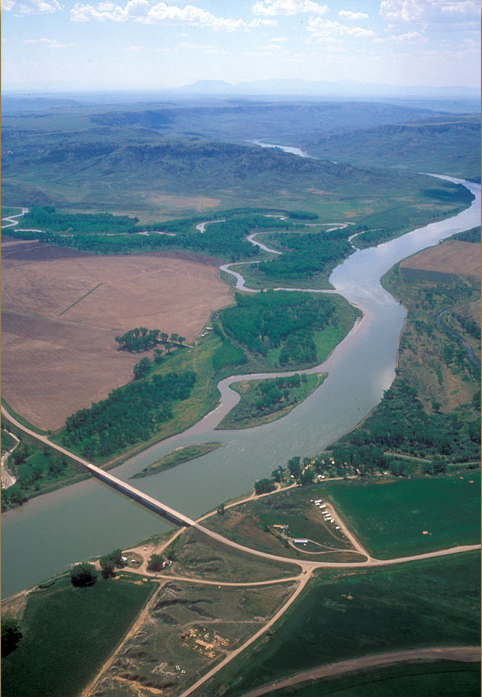The Missouri River flows toward the bottom of the photo.
The Judith River enters it a little above midpoint,
contributing some silt from the spring freshet.
Early on the morning after their near-catastrophic encounter with the bull buffalo on the night of 28 May 1805, the Corps shoved off at an early hour and “proceeded as usual by the Chord”—the cordelle or tow-rope.
at the distance of 2½ miles passed a handsome river which discharged itself on the Lard. side, I walked on shore and acended this river about a mile and a half in order to examine it. I found this river about 100 yds. wide from bank to bank, the water occupying about 75 yard. the bed was formed of gravel and mud with some sand; it appeared to contain much more water as the Muscle-Shell river, was more rappid but equally navigable; there were no large stone or rocks in it’s bed to obstruct the navigation; the banks were low yet appeared seldom to overflow; the water of this River is [clearer] than any we have met with great abundance of the Argalia or Bighorned animals in the high country through which this river passes. Cap. C who assended this R. much higher than I did has call[ed] it Judieths River. The bottoms of this stream as far as I could see were wider and contained more timber than the Missouri.
At first Lewis called it the Big Horn River, from the great numbers of bighorn sheep he saw during his own brief exploration of it, but he soon acceded to Clark’s sentimental gesture.
Just upriver from its confluence with the Missouri, perhaps on the river bottom between the Judith and the height called “Missouri Bench,” he counted “the remains of the fires of 126 Indian lodges which appeared to be of very recent date perhaps 12 or 15 days.” Clark saw similar evidence of an encampment on the north side of the Missouri.
The Indian woman with us examined the mockersons which we found at these encampments and informed us that they were not of her nation the Snake Indians, but she believed they were some of the Indians who inhabit the country on this side of Rocky Mountains and North of the Missoury and I think it most probable that they are the Minetares of Fort de Prarie.[1]The “Minetares of the Prairie Fort” were the Atsinas, a tribe closely allied with the Blackfeet. Their tribal name is from a Blackfeet word believed to mean “gut people,” … Continue reading
The nearest towns of any size are Havre (pronounced Have-er; pop. 9,621), 57 miles north (right of photo), and Lewistown, 48 miles south (left of photo; pop. 5,813). The mountains on the hazy horizon are the Highwoods, 50 miles to the southwest. They comprise the island chain which, two days earlier and some 30 miles down the river at the mouth of today’s Cow (their Windsor’s) Creek, Lewis and Clark had mistaken for part of the Rocky Mountains.The Judith River rises in the Little Belt Mountains approximately 60 miles southwest of Lewistown, Montana, and flows for 130 miles northward to join the Missouri.[2]River Mile Index of the Missouri River, Water Resources Division, Montana Department of Natural Resources and Conservation (January, 1979), 53-59. It had no Indian name as far as the captains knew, so William Clark named it for his young cousin, Julia (“Judith”) Hancock, whom he had met several years before the expedition, and married 16 months after he returned. Its name also identifies one of the most important dinosaur fossil beds on the High Plains, the late Cretaceous Judith River Group.
Notes
| ↑1 | The “Minetares of the Prairie Fort” were the Atsinas, a tribe closely allied with the Blackfeet. Their tribal name is from a Blackfeet word believed to mean “gut people,” which French traders translated as Gros Ventres—”big bellies”—from the descriptive sign-language gesture. The Corps’ neighbors at Fort Mandan, the Hidatsas, came to be known as the Minitaris or Gros Ventres “of the Missouri,” to distinguish them from the Atsinas, the Gros Ventres “of the Prairies.” Moulton, Journals, 4:214 n. |
|---|---|
| ↑2 | River Mile Index of the Missouri River, Water Resources Division, Montana Department of Natural Resources and Conservation (January, 1979), 53-59. |

